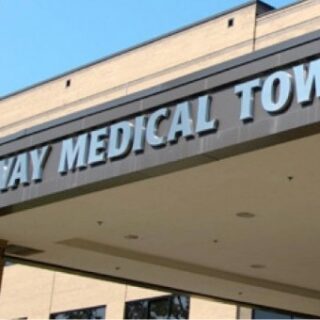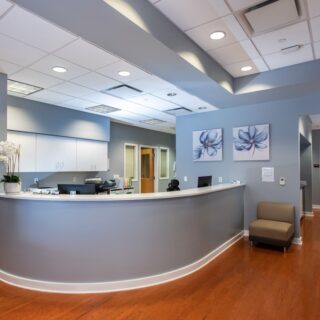Speak with Our Team
A member of our patient care team would be happy to walk you through what to expect, answer your questions and help you get started with your treatment process.
Just because Embolization CAN be done does not mean it is the RIGHT thing to do.
Consider the following:
And most importantly for patients who want pregnancy:

A member of our patient care team would be happy to walk you through what to expect, answer your questions and help you get started with your treatment process.
When considering fibroid treatment, there is NO BETTER OPTION than the LAAM procedure performed by CIGC Hyper-Specialists.
"After being told that I could only have an open myomectomy or hysterectomy it was a relief to hear some positive. CIGC by the grace of God removed 17 fibroids from uterus. I'm gonna yell to the rooftops about CIGC!"
"CIGC performed my myomectomy…the entire process was wonderful. My recovery was quick….I only missed a little over a week of work. The incision from the procedure is just a small line..barely noticeable. I recommend CIGC to any who needs to have a myomectomy."
"Being out of the country, they made the phone consultation easy. The surgery went well, I barely required pain meds post-op, and you would not even know I had a surgery looking at my abdomen. I have been pain free ever since."
"CIGC removed 25 fibroids while preserving my uterus all in a minimally invasive way that had me able to caretake for myself the day after surgery…truly a blessing to the medical profession, most of which is quick to suggest hysterectomy. If I did not find CIGC, I am almost certain I would not have my uterus."

LAAM is a minimally invasive method to remove fibroids from the uterus from any location or any size or number, with a recovery back to work in 7 to 14 days. LAAM is a proven, powerful option for fibroid treatment for ALL patients that is safe, effective, and has been performed successfully in thousands of patients.
Learn More about LAAM
*Embolization can potentially increase the risk of miscarriage
^Embolization can potentially decrease blood flow to the ovaries
See reference articles below

LAAM provides immediate relief of symptoms while preserving fertility. Embolization should NOT be used for fertility.
(*potential risk – due to persistence of fibroids)
(^potential risk – due to blockage of ovarian blood supply)
For more information and references, please review Important Points on Uterine Fibroid Embolization (UFE) and LAAM with Citations at the end of the discussion.
How They Work
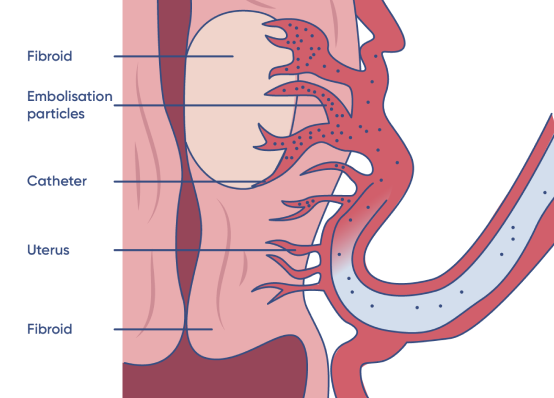
Embolization is a minimally invasive procedure in which plastic “beads” are injected into the arteries that supply fibroids with blood. The plastic particles decrease the blood supply to the fibroids, ultimately killing them. Over time, the fibroids decrease in size, however all fibroids may not respond well to embolization. Larger fibroids have poorer results than smaller fibroids. Fibroids near the lining of the uterus will discharge foul smelling material through the vagina. Fibroids on stalks are often not treated well with embolization and respond poorly. Embolization is not good at treating many fibroids in the uterus, and in general will only treat larger fibroids. Smaller fibroids can grow and increase in size over time since they are not treated.
Death of the fibroids often results in pain due to uterine contractions. Embolization does NOT remove fibroids, meaning that the symptoms from fibroids are not treated immediately. Since fibroids remain in the uterus, an increase in miscarriage rates can occur with fibroids on or near the uterine lining where the pregnancy implants or grows. The plastic beads from embolization can back up into the ovaries, decreasing blood supply to the ovaries and affecting ovarian health and function.
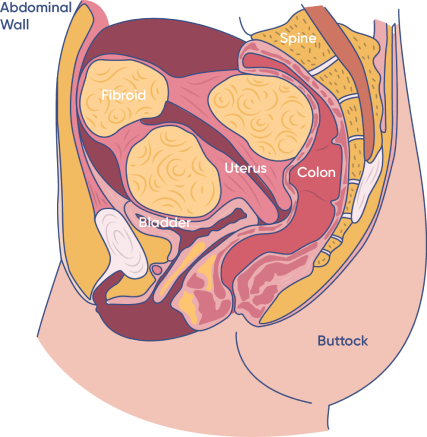
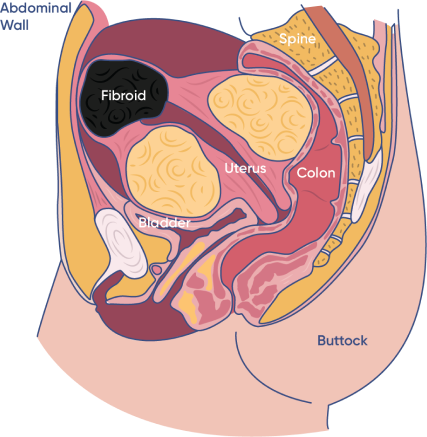

Myomectomy is a surgical procedure that removes fibroids. The CIGC Laparoscopically Assisted Abdominal Myomectomy (LAAM®) is a minimally invasive surgical procedure that can remove fibroids of any size and allow patients to go back to work in two weeks.
Benefits of Myomectomy
With LAAM myomectomy, there is immediate relief of symptoms since the fibroids are completely removed in a one hour procedure, and in general most all fibroids are removed with this procedure. Bleeding, pelvic pain and pressure, back and leg pain, and frequency of urination are completely resolved after LAAM. Since LAAM removes fibroids, it will decrease miscarriage rates – the ability of the pregnancy to implant and grow is better with LAAM since the fibroids are removed and pregnancy success is increased. LAAM will NOT affect ovarian blood supply so that ovarian health and function is normal. Embolization can decrease ovarian blood flow in some patients, which can compromise ovarian health.



LAAM is a minimally invasive surgical procedure performed by CIGC fellowship-trained surgeons. CIGC has performed LAAM extensively and currently has the largest published data series on this procedure, comparing LAAM to robotic, laparoscopic, and open surgery with far better results.
LAAM surgery uses a small incision, usually 1-1.5 inches in size in the bikini line. LAAM procedures remove fibroids from the uterus and do not affect the ovarian blood supply. Removal of the fibroids treats the symptoms of fibroids immediately.
CIGC is focused on providing patients the highest quality of care, the fastest recovery, and the least amount of pain at the lowest possible cost. For patients with fibroids, the LAAM procedure is a revolutionary treatment approach that is superior to UFE. LAAM is performed in a surgery center setting that is safer, far more convenient and patient-friendly, with much lower cost than hospital-based procedures. LAAM myomectomy is the procedure of choice for any patient that desires to become pregnant or wants the best option for treatment of fibroid symptoms immediately, safely and effectively.
The LAAM procedure has been proven superior to other minimally invasive techniques and open surgery. In addition, we have shown that these procedures can be performed safely and more efficiently in an ambulatory surgery center. Our nationally and internationally renowned techniques have been published in prestigious medical journals due to exceptional patient outcomes.

Discover the risks associated with pregnancy and menopause. (see corresponding numbered references below)
UFE should not be used on any patient who wants to become pregnant since UFE can decrease pregnancy rates and increase the risk of miscarriage and other complications in pregnancy. (4,5,8)
UFE can significantly decrease blood supply to the ovaries, which significantly affects ovarian egg reserve (studies showed a significant decline in egg numbers in the ovaries) and decrease pregnancy rates. (1,2,3,6,7)
Decreased blood supply to the ovaries will also increase the risk of menopause. (1,2,3,4,5,6,7,8,13)
LAAM is the procedure of choice for fibroid removal in pregnant patients.
LAAM can increase pregnancy rates and enhance fertility. LAAM does not decrease blood supply to the ovaries. With the LAAM technique, all the fibroids, including submucosal ones, are removed.
Women who underwent myomectomy had a greater pregnancy rate. Pregnancy is significantly more common after myomectomy, while a miscarriage risk was higher after UFE (Uterine Fibroid Embolization). (4,5)
UFE will NOT immediately treat many symptoms of fibroids and may require months or years – or possibly never – to eliminate those symptoms. Therefore, patients will need reintervention in the future. (7,9)
LAAM procedures provide immediate relief of symptoms with a one-hour procedure. All the fibroids are removed, thereby eliminating the symptoms of fibroids in one session.
UFE does not have a faster recovery than LAAM myomectomy.
LAAM provides a faster recovery in most cases, with far less pain.
The rates of unscheduled visits and readmission are higher in UAE than with surgical interventions. (9)
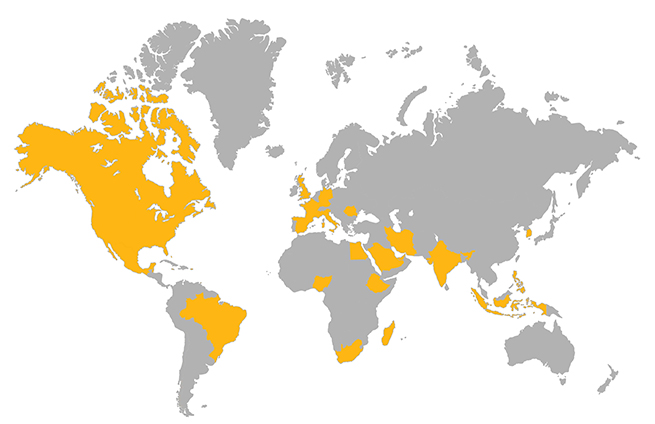
Seek the gynecological treatment you deserve.
1. Hehenkamp W et al. (2007): Ovarian failure was reported in 12 percent and 18 percent at 12 and 24 months, respectively. Levels of AMH were significantly lower, indicating ovarian aging at each follow-up up to 24 months after UAE.
2. Volkers N et al. (2007): The EMMY trial reported one unplanned pregnancy after UAE at 24 months.
3. Rashid S et al. (2010): A similar proportion of 73 women (11%) were observed to have menopausal levels of FSH at 12 months after UAE in the REST study.
4. Mara M et al. (2008): In a younger study population, the risk of elevated FSH >10 IU/L after the intervention was higher among those with UAE (13.8%) than myomectomy (3.2%).
5. Edwards R et al. (2007): The REST trial reported seven pregnancies after UAE at 12 months which included four miscarriages, two live births, and one intrauterine fetal death at 33 weeks. For women with submucous fibroids, the group who underwent myomectomy had a greater pregnancy rate (40.4%) than those who did not undergo surgery (21.4 percent).
6. El Shamy T et al. (2020): A meta-analysis of six studies and 353 participants demonstrated a significant decline at 3 months in antral follicle count after UAE.
7. Hartmann KE et al. (2017): Rates of ovarian failure after UAE (defined as a follicle-stimulating hormone level greater than 40 IU/L at 1 year after treatment) have been reported to be as high as 12% and 18% at 12 and 24 months. Rates of reintervention (with hysterectomy, repeat embolization, myomectomy, medical management, or endometrial ablation) as high as 19–38% have been reported 2–5 years after UAE. Major complications of UAE have been reported in 1–12% of cases and may include unplanned hysterectomy, rehospitalization, ovarian failure, and pulmonary embolism. Minor complications occur in 21–64% of cases and are variably defined among different UAE studies. Minor complications may include pain, fever, and nausea associated with postembolization syndrome; vaginal discharge; and pelvic infection.
8. Homer H, Saridogan E. (2010): Compared with expectant management and matched for age and leiomyoma location, uterine leiomyoma treatment with UAE is associated with an increased risk of pregnancy loss (35.2% versus 16.5%; OR, 2.8; 95% CI, 2.0–3.8), a cesarean delivery (66% versus 48.5%; OR, 2.1; 95% CI, 1.4–2.9), and postpartum hemorrhage (13.9% versus 2.5%; OR, 6.4; 95% CI, 3.5–11.7).
9. Gupta JK et al. (2014): The risk of requiring further surgical intervention within 2 years after UAE has been reported to be twofold to fivefold higher compared with hysterectomy or myomectomy. Compared with any type of surgery for uterine leiomyomas, UAE is associated with similar rates of major postprocedural complications (OR, 0.65; 95% CI, 0.33–1.26); however, UAE has a higher rate of minor postprocedural complications (OR, 1.99; 95% CI, 1.41–2.81). The rates of unscheduled visits and readmission are higher in UAE than with surgical interventions.
10. Carrillo TC et al. (2008): Major complications of UAE have been reported in 1–12% of cases and may include unplanned hysterectomy, rehospitalization, ovarian failure, and pulmonary embolism. Minor complications occur in 21–64% of cases and are variably defined among different UAE studies.
11. ACOG Practice Bulletin No. 228
12. AHRQ Publication No. 17(18)-EHC028-EF: Because of the small numbers and heterogeneity of methods, there is insufficient evidence to make any conclusions about uterine artery occlusion.
13. Sentilhes L, Vayssière C, Beucher G, et al. (2013): UAE has limitations, such as subclinical damage of the ovarian function (especially in women older than 45 years).
14. Van der Kooij SM, Bipat S, et al.(2011). UAE has limitations, such as the potential risk of reintervention or subsequent hysterectomy.
15. Karlsen et al. (2018): Reported that UAE may lead to lower pregnancy rates and higher miscarriage rates than myomectomy.
16. Davis MR, Soliman AM, Castelli-Haley J, et al. (2018). The reintervention rate for UAE was lower than that for EA but higher than that for myomectomy. Prior anemia, bleeding, pelvic inflammatory disease, and pelvic pain might increase the risk of reintervention.
17. Yuehan Wang1 , Shitai Zhang1 , Chenyang Li2 , Bo Li1 , Ling Ouyang1. The UAE is not suitable for women who want to preserve their fertility.
18. MacKoul et al. Comparison of different myomectomy procedures (robotic, laparoscopic, open) with faster recovery and discharge from the hospital, lower complications, and less cost with LAAM
19. Danilyants et al. Comparison of LAAM performed in the outpatient ASC setting vs. hospital.
20. MacKoul et al. Feasibility of LAAM
Explore The Center for Innovative GYN Care® (CIGC®) locations across the United States.
